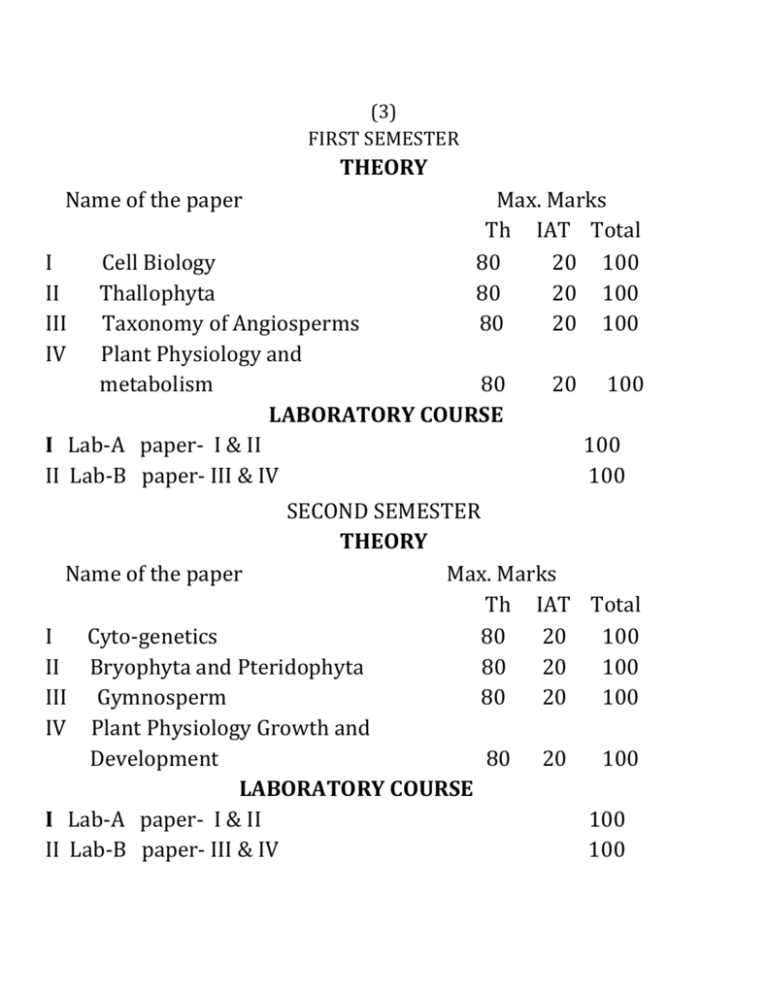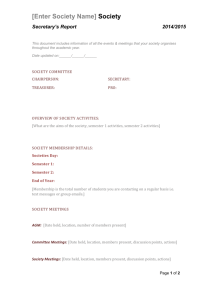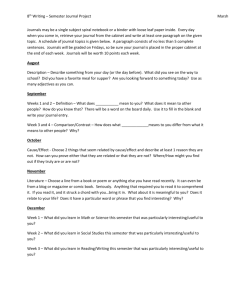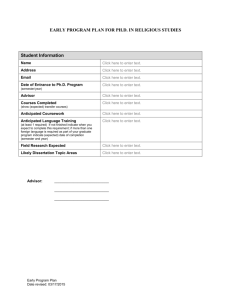Botany - rajeev gandhi govt post graduate college, ambikapur
advertisement

(3) FIRST SEMESTER THEORY Name of the paper I II III IV Max. Marks Th IAT Total 80 20 100 80 20 100 80 20 100 Cell Biology Thallophyta Taxonomy of Angiosperms Plant Physiology and metabolism 80 LABORATORY COURSE I Lab-A paper- I & II II Lab-B paper- III & IV 20 100 100 100 SECOND SEMESTER THEORY Name of the paper Max. Marks Th IAT Total I Cyto-genetics 80 20 100 II Bryophyta and Pteridophyta 80 20 100 III Gymnosperm 80 20 100 IV Plant Physiology Growth and Development 80 20 100 LABORATORY COURSE I Lab-A paper- I & II 100 II Lab-B paper- III & IV 100 (4) THIRD SEMESTER THEORY Name of the paper I II III IV Max. Marks Th IAT Total 80 20 100 80 20 100 80 20 100 Plant Development Ecology Biotechnology Plant Tissue Culture Spl.-Plant Pathology, General 80 LABORATORY COURSE I Lab-C paper- I & II II Lab-D paper- III & IV 20 100 100 100 FOURTH SEMESTER THEORY Name of the paper Max. Marks Th IAT Total 80 20 100 80 20 100 I Embryology II Environmental Biology III Genetic Engineering of Plants and Microbes 80 20 100 IV Spl.-Plant Pathology, Diseases 80 20 100 LABORATORY COURSE I Lab-C paper- I & II 100 II Lab-D paper- III & IV 100 (5) M. Sc. Botany,FIRST SEMESTER PAPER-I CELL BIOLOGY Cytology: Outline of the chemical and physiochemical organization of the cell. Plasma membrane, cell wall, cytoplasmic organelles (Chloroplast, Mitochondria, Nucleus, Ribosome, Endoplasmic reticulum ,Golgi Body, Peroxisomes, Lysosomes and micro – organales) their structure and functions .Cell Division. Genetics of Prokaryotes and Eukaryotic Organelles: Mapping the bacteriophage genome, phage phenotypes, genetic recombination in phage, genetic transformation, conjugation and transduction in Bacteria. Chromosome: Morphology and fine structure of chromosome. Structure and numerical changes in chromosomes. Gene Structure and Expression: Genetic fine structure, cis-trans test, fine structure analysis of eukaryotes, introns and their significance, RNA splicing, regulation of gene expression in prokaryotes and eukaryotes. (6) M. Sc. Botany, FIRST SEMESTER PAPER-II THALLOPHYTA Microbiology: General account, ultra structure, nutrition and reproduction, biology and economic importance of Bacteria, Cyanobacteria, Viruses and phyto-plasma. Mycology: General characters and reproduction of fungi, classification, nutrition and economic importance of fungi, Genral account of following groups of fungi:- Mastigomycotina, Zygomycotina, Ascomycotina, Basidiomycotina and Deuteromycotina. Phycology : General characters, habitats, systematic study of range of thallus structure, organization, reproduction, classification, economic importance of algae. Phylogeny and interrelationship of following groups of algae:- Cholorophyta, Charophyta, Xanthophyta, Bacillariophyta, Phaeophyta and Rhodophyta. (7) M. Sc. BOTANY, FIRST SEMESTER PAPER-III TAXONOMY OF ANGIOSPERMS The species concepts: Taxonomic hierarchy, species, genus, family and other categories, principles used in assessing relationship, delimitation of taxa and attribution of rank. Salient features of the International code of botanical nomenclature. Taxonomic evidence : Morphology, Anatomy, Palynology, Embryology, Cytology, Phytochemistry, Genome analysis and nucleic acid hybridization, computer and GIS. Taxonomic tools: Herbarium, Floras. Dicotyledons: Order- Ranales, Peritales, Malvales, Geraniales, Rosales, Myrtales, Umbellales, Rubiales, Asterales, Gentiales, Polymoniales, Lamiales, and Unisexuales. Monocotyledons: Microspermae, Coronarieae, Calycineae and Glumaceae. Systems of angiosperm classification: Phenetic verses phylogenetic systems, cladistics in taxonomy, relative merits and demerits of major systems of classification, relevance of taxonomy to conservation. (8) M. Sc. Botany,FIRST SEMESTER PAPER-IV PLANT PHYSIOLOGY AND METABOLISM Energy Flow: Principles of Thermodynamics, Free energy and chemical potential, Redox reaction, structure and functions of ATP. Fundamentals of enzymology: General aspects, allosteric mechanism, regulatory and active sites, isozymes, kinetics of enzymatic catalysis, Michaelis-Menten’s eqation and its significance. Membrane transport and translocation of water and solutes: Plant-water relations, mechanism of water transport through xylem, root microbe interactions in facilitating nutrient uptake, comparison of xylem and phloem transport, phloem loading and unloading, passive and active solute transport, membrane transport proteins. Signal transduction: Overview receptors and G-proteins, phospholipid signaling , role of cyclic nucleotides , Calcium-calmodulin cascade, diversity in protein kinases and phosphatases, specific signaling mechanism, e.g. twocomponent sensor regulator system in bacteria and plant, sucrose sensing mechanism. Photochemistry and Photosynthesis: General concepts and historical background , evolution of photosynthetic apparatus, photosynthetic pigments and light harvesting complexes, photo-oxidation of water, Mechanisms of electron and proton transport, carbon assimilation- the Calvin cycle, photorespiration and its significance, the C4 cycle, the CAM pathway, biosynthesis of starch and sucrose, physiological and ecological considerations. Respiration and lipid metabolism : Overview of plant respiration, glycolysis, the TCA cycle, electron transport and ATP synthesis, pentose phosphate pathway, glyoxylate cycle, alternative oxidase system, structure and function of lipid, fatty acid biosynthesis, synthesis of membrane lipids ,structural lipids, storage lipids and their catabolism. (9) M. Sc. BOTANY, SECOND SEMESTER PAPER-I CYTOGENETICS Genetic recombination and genetic mapping: Recombination, independent assortment and crossing over, molecular mechanism of recombination, role of RecA and RecBCD enzymes , site specific recombination, chromosome mapping, linkage groups, genetic markers, construction of molecular maps, correlation of genetic and physical maps, somatic cell genetics, an alternative approach to gene mapping. Mutation: DNA demage and repair mechanisms, inherited human diseases and defects in DNA repair, initiation of cancer at cellular level, proto-oncogenes and oncogenes. Molecular Cyto-genetics: Nuclear DNA content, C-value paradox, Cot curve and its significance, restriction mapping-concept and techniques, multigenes families and their evolution, in situ hybridization-concept and techniques, physical mapping of genes on chromosomes. (10) M. Sc. BOTANY, SECOND SEMESTER PAPER-II BRYOPHYTA AND PTERIDOPHYTA Bryophyta : General characters, structure, distribution, reproduction, classification and life history of following groups of Bryophytes :Marchantiales, Jungermaniales, Anthocerotales, Sphagnales, Funariales and Polytrichales maintioning its economic and ecological importance. Pteridophyta: General character, reproduction, classification of following groups of Pteridophytes:Psilopsida, Lycopsida, Sphenopsida, Pteropsida and fossil pteridophytes. A special mention must be made about evolution of stele, heterospory and origin of seed habit in pteridophyta. (11) M. Sc. Botany, SECOND SEMESTER PAPER-III GYMNOSPERM Introduction: Gymnosperms, the vessel-less and fruitless seed plants varying in the structure of their sperms, pollen grains, pollen germination and the complexity of their female gametophytes, evolution of gymnosperms. Classification of Gymnosperms and their distribution in India. Brief account of the families (Lyginopteridaceae, Medullosaceae, Glossopteridaceae). of Pteridospermales: Caytoniaceae and General Account of Cycadeoidales and Cordaitales. Structure and reproduction in Cycadales, Ginkgoales, Coniferales, Ephedrales , Welwistschiales and Gnetales. (12) M. Sc. BOTANY, SECOND SEMESTER PAPER-IV PLANT PHYSIOLOGY GROWTH AND DEVELOPMENT Nitrogen fixation, Nitrogen and Sulphur metabolism: Overview, biological nitrogen fixation, nodule formation and nod factors, mechanism of nitrate uptake and reduction, ammonium assimilation, sulphate uptake, transport and assimilation. Sensory Photobiology: History of discovery of phytochromes and cryptochromes and their photochemical and biochemical properties, photophysiology of light-induced responses, cellular localization, molecular mechanism of action of photo-morphogenic receptors, signaling and gene expression. Plant growth regulators and plant movement: Physiological effects and mechanism of action of auxins, gibberellins, cytokinins, ethelene, abscisic acid, hormone receptors, signal transduction and gene expression, plant movements. The flowering process: Photoperiodism and its significance, endogenous clock and its regulation, floral induction and development- genetic and molecular analysis, role of vernalization. Stress physiology: Plant responses to biotic and abiotic stress , mechanisms of biotic and abiotic stress tolerance, HR and SAR water deficit and drought resistance, salinity stress, metal toxicity, freezing and heat stress, oxidative stress. (13) M. Sc. BOTANY, THIRD SEMESTER PAPER-I PLANT DEVELOPMENT Seed germination and seedling growth: Metabolism of nucleic acids, proteins and mobilization of food reserves; tropisms, hormonal control of seeding growth, gene expression, use of mutants in understanding seeding development. Shoot development: Organization of the shoot apical meristem (SAM),cytological and molecular analysis of SAM, control of cell division and cell to cell communication, control of tissue differentiation, Specially xylem and phloem, secretary ducts and laticifers, wood development in relation environmental factors. Anatomy of root - stem transition. Leaf growth and differentiation : Determination , phyllotaxy, control of leaf form, differentiation of epidermis (with special reference to stomata and trichomes) and mesophyll. Root development: Organization of root apical meristem (RAM), cell fates and lineages, vascular tissue differentiation, lateral roots, root hairs, root microbe interactions. Latent life-dormancy: Importance and types of dormancy, seed dormancy, overcoming seed dormancy, bud dormancy. Senescence and programmed cell death (PCD): Basic concepts, types of cell death, PCD in the life cycle of plants, ,metabolic changes associated with senescence and its regulation, influence of hormones and environmental factors on senescence (14) M. Sc. BOTANY, THIRD SEMESTER ECOLOGY PAPER-II Vegetation organization: Concepts of community and continuum, analysis of communities (analytical and synthetic characters), community coefficients, interspecific associations, ordination, concept of ecological niche. Vegetation development : Temporal changes (cyclic and non-cyclic ), mechanism of ecological succession (relay floristic and initial floristic composition, facilitation, tolerance and inhibition models), changes in ecosystems properties during succession. Ecosystem organization: Structure and functions, primary production (methods of measurement, global pattern, controlling factors), energy dynamics (trophic organization energy flow pathways, ecological efficiencies),litter fall and decomposition( mechanism, substrate quality and climatic factors ), global biogeochemical cycles of C,N,P and S, mineral cycles (pathways, processes, budgets) in terrestrial and aquatic ecosystems. Origin of intrapopulation variation: Population and the environment, ecades and ecotypes, evolution and differentiation of species-various models. (15) M. Sc. BOTANY, THIRD SEMESTER PAPER-III BIOTECHNOLOGY PLANT TISSUE CULTURE Biotechnology: Basic concepts, principles and scope. Plant cell and tissue culture: General introduction, history, scope, concept of cellular differentiation, totipotency. Organogenesis and adventitive embryogenesis: Fundamentals aspects of morphogenesis, somatic embryogenesis and androgenesis, mechanisms, techniques and utility. Somatic hybridization: Protoplast isolation, fusion and culture, hybrid selection and regeneration, possibilities, achievements and limitations of protoplast research. Application of plant tissue culture: Clonal propagation, artificial seed, production of hybrids and somaclones, production of secondary metabolites/natural products, cryopreservation and germplasm storage. (16) M. Sc. BOTANY, THIRD SEMESTER PAPER-IV SPECIAL- PLANT PATHOLOGY, GENERAL History of plant pathology: General characteristics of fungi, bacteria and viruses, their hetrotrophic behaviour with emphasis on parasitism parasitic ability and virulence. Symptomatology : General symptoms of plant diseases, pathogenic and non-pathogenic. Pathogenicity: Distribution of plant pathogens, mode of infection, inoculum and inoculum potential, koch’s postulates. Host parasite relationship: Physiology of infection, role of enzymes and toxins in pathogenesis. Defence of plant against pathogens, resistance and susceptibility, by par sensitive reaction phytoalexin, disease syndrome. Effect of environment: Predisposition and stress, epidemiology and disease forecasting, source of infection i.e. seed, soil, water and air born diseases of plants, significance of phyllosphere and rhizosphere studies, recurrence of diseases. (17) M. Sc. BOTANY, FOURTH SEMESTER PAPER-I EMBRYOLOGY Reproduction: Vegetative options and sexual reproduction, flower development, genetics of floral organ differentiation, homeotic mutants in Arabidopsis and Antirrhinum, sex determination. Male gametophyte: Structure of anthers, microsporogenesis, role of tapetum, pollen development and gene expression, male sterility, sperm dimorphism and hybrid seed production, pollen germination, pollen tube growth and guidance, pollen storage, pollen allergy, pollen embryos. Female gametophyte: Ovule development, megasporogenesis, organization of the embryo sac, structure of the embryo sac cells. Pollination, pollen-pistil interaction and fertilization: Floral characteristics, pollination mechanisms and vectors, breeding systems, commercial considerations, structure of the pistil, pollen stigma interactions, sporophytic and gametophytic selfincompatibility (cytological, biochemical and molecular aspects), double fertilization, in vitro fertilization. Seed development and fruit growth: Endosperm development during early, maturation and desiccation stages, embryogenesis, ultra structure and nuclear cytology, cell lineages during late embryo development, storage proteins of endosperm and embryo, polyembryony, apomixis, embryo culture, dynamics of fruit growth, biochemistry and molecular biology of fruit maturation. M. Sc. BOTANY, FOURTH SEMESTER (18) PAPER-II ENVIRONMENTAL BIOLOGY Air, water and soil pollution: Kinds, sources, quality parameters, effects on plants and ecosystems. Ecological management: Concepts, sustainable development, sustainability indicators. Origin, evolution, cultivation and uses of : (i) Food, forage and fodder crops (ii) fiber crops (iii) medicinal and aromatic plants and (iv) vegetable oil- yielding crops. Important fire –wood and timber-yielding plants and non- wood forest products (NWFPs): such as bamboos, rattans, raw materials for paper –making, gums, tannins, dyes, resins, and fruits. Strategies for conservation- in situ conservation : International efforts and Indian initiatives, protected areas in India- sanctuaries, national parks, biosphere reserves, wetlands, mangroves and coral reefs for conservation of wild biodiversity. Strategies for conservation –ex situ conservation: Principles and practices, botanical gardens, field gene banks, seed banks, in vitro repositories, cry banks, general account of the activities of Botanical survey of India (BSI), National Bureau of plant genetic resources (NBPGR), Indian Council of Agricultural Research (ICAR), Council of scientific and Industrial Research (CSIR) and the Department of Biotechnology (DBT) for conservation, non-formal conservation efforts. Sustainable utilization of bio-resources and ecosystem research. Concepts of Phyto-geography : Endemism , Hotspots and hottest hotspots, plant explorations, invasions and introductions, local plant diversity and its socio- economic importance. (19) M. Sc. BOTANY, FOURTH SEMESTER PAPER-III GENETIC ENGINEERING OF PLANTS AND MICROBES Recombinant DNA technology: Gene cloning principles and techniques, construction of genomic/cDNA libraries, choice of vectors, DNA synthesis and sequencing, polymerase chain reaction, DNA fingerprinting. Genetic engineering of plants : Aims , strategies for development of transgenics (with suitable examples), Agrobacterium- the natural genetic engineer, T-DNA and transposon mediated gene tagging, chloroplast transformation and its utility, intellectual property rights, possible ecological risks and ethical concerns. Microbial genetic manipulation: Bacterial transformation, selection of recombinants and transformants, genetic improvements of industrial microbes and nitrogen fixers, fermentation technology. Genomics and proteomics : Genetic and physical mapping of genes, molecular markers for introgression of useful traits, artificial chromosomes, high throughput sequencing, genome projects, bioinformatics, functional genomics, microarrays, protein profiling and its significance. (20) M. Sc. BOTANY, FOURTH SEMESTER PAPER-IV SPECIAL- PLANT PATHOLOGY, DISEASES Control of plant diseases: Principles of plant disease control, methods of control e.g. regula tory chemical: biological and breeding of resistant varieties of host plants, plant quarantine. Details of disease cycle: Crop-loss estimates and recommended control for the important diseases caused by fungi, bacteria, viruses, mycoplasma and nematodes, in the following crop plants . (a) (b) (c) (d) (e) Wheat, Rice, Bajara, Maize, Sugarcane. Arhar, Gram, Pea. Groundnut, Till, Iinseed, Cotton. Chilies, Tomato, Potato, Brinjal, Coriander, Tobacco. Citrus fruits e.g. lemon, Orange, Musammi, Papaya, Apple, Banana. (2) SCHEME FOR THE THEORY AND LABORATORY COURSES The postgraduate course in Botany shall extend over a period of two academic years comprising of four semesters. The syllabi and scheme of examination of those courses are detailed below. The four semester M.Sc. courses shall consist of sixteen theory and six practical courses. In each semester there shall be four theory courses, each of 80 marks and 2 marks for internal assessment test. In internal assessment test there will be 12 marks for two written tests and 08 marks for a seminar in each paper. Thus there shall be T+I=100 marks for each paper, minimum passing and qualifying marks shall be 36% each. Student will have to obtain 10 marks in internal assessment of each paper .Candidate will be required to pass separately in the total of the theory courses and in the total of the practical courses, student will have to attempt any four questions out of six questions in each theory paper. In Ist and IInd semester, there will be two practical / laboratory courses each of 100 marks, conducted at the end of semester. In IIIrd and IVth semester, there will be two practical /laboratory courses, each of 100 marks conducted at the end of semester. (1) RAJIV GANDHI GOVERNMENT POST GRADUATE (AUTONOMOUS) COLLEGE AMBIKAPUR SYLLABUS POSTGRADUATE COURSES IN BOTANY Under semester system to be implemented from the Session 2013-14 SCHEME FOR THE THEORY AND LABORATORY COURSES DEPARTMENT OF BOTANY, RG GOVT. PG COLLEGE AMBIKAPUR To, The Principal, RG Government Postgraduate Collage Ambikapur, Dist.- Surguja (C.G.) Subject:- REQUEST FOR PAYMENT OF MEDICAL LEAVE. Respected sir, With due respect and humble submission, I lay down the following few lines for your kind consideration and favorable action please. I Mrs Leela Sahu D/O Shri Shivram Sahu serving with your kind command in this college as lab technician since may 2010. Payment of my 14 days medical leave 2010 has not been paid to me by the concerned office. The details of my leave are as under:(a) (b) 9 days medical leave with effect from 23 august 2010 to 31 august 2010. 5 days medical leave with effect from 01 September 2010 to 05 September 2010. My 02 days salary with effect from 21 august 2010(Saturday) and 22 august 2010(Sunday) has not been paid to me due to I was not signed the register on 21 august 2010(Saturday). The register was kept in alameda of head clerk due to third Saturday of the month and head clerk was also on leave and my leave was started from 23 august 2010(Monday). In view of the above , I request your honor to give the order to pay my 14 days medical leave and 02 days balance salary to me at the earliest. ‘Thanking you’ Date- /07/2011 Your sincerely Miss Leela Sahu Lab Technician RG GOVT. PG COLLEGE AMBIKAPUR sTo, The Principal, RG Government Postgraduate Collage Ambikapur, Dist.- Surguja (C.G.) Subject :- Request for sanction of 09 days E. L. and payment of balance amount (salary for 23 days). Respected sir, With due respect and humble submission, I lay down the following few lines for your kind consideration and favorable action please. I miss Leela Sahu D/O shri Shivram Sahu serving with your kind command in this college as lab technician since may 2010. I was join the duty on 21 may 2010 and leave the college on 22 may 2010 after your permission. I was also join the duty on 24 June 2010. My salary with effect from 01 June 2010 to 23 June 2010 has not been paid to me till date. You are requested to sanction my 09 days E.L. with effect from 15 June 2010 to 23 June 2010 and also requested to give the order to pay my salary for 23 days with effect from 01 June 2010 to 23 June 2010 to me. In view of the above ,I request your honor to give suitable order at the earliest please. ‘Thanking you’ Date- /07/2011 Your sincerely Miss Leela Sahu Lab Technician RG GOVT. PG COLLEGE AMBIKAPUR








